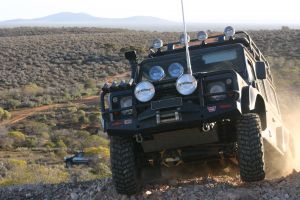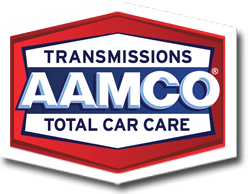Many cars these days are all-wheel drive, or AWD, and sometimes this term is confused with four-wheel drive, or 4WD. It’s important to understand that the two are not the same. AWD is different than 4WD, and here’s how.
Four-Wheel Drive (4WD)
A car with 4WD is sometimes referred to as a 4x4. Four-wheel drive is used on off-road vehicles, or vehicles that will most likely be used in such extreme terrain environments that require low, careful speeds and rugged drive system performance.
In 4WD, power goes from the transmission to the transfer case, which divides power between the front and rear axles so that maximum torque is going to each wheel. When the transfer case distributes power evenly, it ensures that each wheel turns at the same speed.  This presents a problem when it comes to turning. When a car makes a turn the inside wheel turns more slowly than the outside wheel, because the outside wheel has to cover more ground. The inside wheel loses traction and spins uselessly if the wheels altogether cannot perform as natural physics require.
This presents a problem when it comes to turning. When a car makes a turn the inside wheel turns more slowly than the outside wheel, because the outside wheel has to cover more ground. The inside wheel loses traction and spins uselessly if the wheels altogether cannot perform as natural physics require.
Modern 4WD systems are activated electronically by a button or switch, instead of the traditional lever. The system includes multiple settings: 4WD High, which allows what is called “limited slip” between the inside and outside wheels. This adjusts the system for the locked, spinning inside wheel as long as the vehicle’s speed does not exceed about 60 miles per hour. 4WD Low, virtually locks the wheels into full four-wheel drive mode for those low speed, crawling sort of off-road conditions in which each wheel is not turning at high speed and all four can effectively work independently (and together).
All-Wheel Drive (AWD)
All-wheel drive systems were developed more recently and are much more complicated than traditional four-wheel drive systems. It is available in many modern cars, from full-size SUV’s to sports cars. The biggest difference between 4WD and AWD is that an AWD system is active all the time.
There are two types of all-wheel drive: mechanical and electronic. AWD systems use three differentials. A differential is a box of gears that transfers power from the transmission and divides it at different points – either between two wheels or between the front and rear axles.
Because an AWD system uses three differentials, it applies power to the wheels that have the most traction by dividing power between the front and rear axles on the center differential, then distributing power to the individual wheels via the front and rear differentials.
This is useful in wet or slippery conditions when different wheels might be getting different amounts of traction. AWD systems are computer controlled, with sensors on the wheels that continuously monitor speed, traction, and other data. An electronic control unit (ECU) processes the data and determines which wheels get power. This method of power control is called “torque vectoring.” But drivers should not be fooled into a false sense of security. AWD does not help the vehicle stop any better or faster in slick conditions. The same goes for 4WD.
 AWD isn’t as heavy-duty as 4WD, and it can’t perform as effectively in low-speed off-road conditions as traditional 4WD systems. It simply is just not meant for performing in such extreme conditions, and the cars built around them are, overall, not engineered for it. AWD is more of a performance and safety option for today’s predominantly all-purpose vehicles. Nor is it as fuel efficient because usually it can’t be turned off. AWD systems also increase the overall weight and complexity of the vehicle, which increases operational and maintenance costs.
AWD isn’t as heavy-duty as 4WD, and it can’t perform as effectively in low-speed off-road conditions as traditional 4WD systems. It simply is just not meant for performing in such extreme conditions, and the cars built around them are, overall, not engineered for it. AWD is more of a performance and safety option for today’s predominantly all-purpose vehicles. Nor is it as fuel efficient because usually it can’t be turned off. AWD systems also increase the overall weight and complexity of the vehicle, which increases operational and maintenance costs.
Four-wheel drive, like all-wheel drive, adds weight and complexity to vehicles, but it can be deactivated, thereby increasing fuel economy and decreasing wear and tear on the system itself. It offers the best traction and performance in off-road conditions and can handle extreme road conditions. It can’t be used in all conditions, or at high speeds, and older vehicles actually might require the vehicle to be stopped in order to engage the 4WD system. Older two-wheel drive models that have a 4WD option actually require the driver to get out of the vehicle and physically turn the wheel hubs to engage the non-drive wheels. For instance, if the vehicle is rear-wheel drive, the front wheel hubs must be turned to engage, or lock, the front wheels to activate the 4WD system.
Whichever kind of car you drive – 4WD or AWD – AAMCO mechanics have the expertise to service and repair your vehicle’s drive system. If you have questions about your all-wheel drive or four-wheel drive system, or need a Vehicle Courtesy Check and repairs, contact your local Colorado AAMCO or schedule an appointment online.

I didn’t realize that 4WD and AWD are so different. My brother-in-law has a four-wheel drive car. Would he need a special mechanic to fix it if it breaks?
Kairi,
Most, if not all mechanics should be well versed in how to deal with different drivetrains. At AAMCO Colorado all of our expert technicians will be able to help your brother with his 4WD vehicle.
Thanks,
AAMCO Colorado